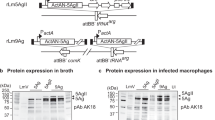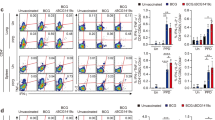Abstract
Tuberculosis is responsible for the deaths of more people each year than any other single infectious disease, with greater than 7 million new cases and 2 million deaths annually1. It remains the largest attributable cause of death in HIV–infected individuals, responsible for 32% of deaths of HIV–infected individuals in Africa2. The only currently available vaccine for tuberculosis, bacille Calmette–Guerin (BCG) is the most widely used vaccine in the world, being administered to approximately 100 million children each year. Although untoward effects were not seen in several studies of HIV–seropositive children3, the safety of live attenuated BCG vaccine in HIV–positive adults remains unknown and a matter of some concern. To obviate potential adverse affects of BCG vaccines in immunodeficient individuals, we have studied five auxotrophic strains of BCG produced by insertional mutagenesis for safety in administration to mice with severe combined immunodeficiency disease (SCID), and for protection in a susceptible strain of mice. The results indicate that viable BCG could no longer be detected in mice receiving the auxotrophs after 16–32 weeks, and that infected SCID mice survived for at least 230 days. In contrast, all SCID mice succumbed within eight weeks to conventional BCG vaccine. When susceptible BALB/c mice were immunized with auxotrophs and subsequently challenged with virulent Mycobacterium tuberculosis, several of the auxotrophs produced comparable protection against intravenous and intratracheal challenge with M. tuberculosis relative to conventional BCG. These results suggest that auxotrophic strains of BCG represent a potentially safe and useful vaccine against tuberculosis for populations at risk for HIV.
This is a preview of subscription content, access via your institution
Access options
Subscribe to this journal
Receive 12 print issues and online access
$209.00 per year
only $17.42 per issue
Buy this article
- Purchase on Springer Link
- Instant access to full article PDF
Prices may be subject to local taxes which are calculated during checkout
Similar content being viewed by others
References
Murray, C.J.L. & Lopez, A.D. Global Comparative Assessments in the Health Sector: Disease Burden, Expenditures and Intervention Packages (eds. Murray, C.J.L. & Lopez, A.D.) 53 (World Health Organization, Geneva, 1994).
Lucas, S. & Nelson, A.M. Pathogenesis of tuberculosis in human immunodeficiency virus infected people. in Tuberculosis, Pathogenesis, Protection and Control (ed. Bloom, B.R.) 503–513 (American Society for Microbiology Press, Washington, DC, 1994).
Program for Immunization. Program Report (World Health Organization, Geneva, 1992).
Styblo, K. Epidemiology of tuberculosis. Selected Papers R. Netherlands Tuberc. Assoc. 24, 1–136 (1991).
Selwyn, P.A. et al. A prospective study of the risk of tuberculosis among intravenous drug abusers with human immunodeficiency virus infection. N. Engl. J. Med. 320, 545–550 (1989).
Rodrigues, L.C., Diwan, V.K. & Wheeler, J.G. Protective efficacy of BCG against tuberculousmeningitisandmiliary tuberculosis: Meta-analysis. Int. J. Epidemiol. 22, 1154–1158 (1993).
Fine, P.E.M. The BCG story: Lessons from the past and implications for the future. Rev. Infect. Dis. 11, S353–S359 (1989).
tenDam, H.G., Toman, K.I., Hitze, K.L., & Guld, J., Present knowledge of immunization against tuberculosis. Bull World Health Organ. 54, 255–269 (1976).
Hart, P.D. & Sutherland, I. BCG and vole bacillus vaccines in the prevention of tuberculosis in adolescence and early adult life. Br. Med. J. 22, 293–295 (1977).
Trial of BCG vaccines in South India for tuberculosis prevention. Indian J. Med. Res. 72, 1–74 (1980).
Bloom, B.R. & Fine, P.E.M. The BCG Experience: Implications for future vaccines against tuberculosis, in Tuberculosis, Pathogenesis, Protection and Control (ed. Bloom, B.R.) 531–557 (American Society for Microbiology Press, Washington, DC, 1994).
Colditz, G.A. et al. Efficacy of BCG vaccine in the prevention of tuberculosis. Meta-analysis of published literature [see comments] (1994). Comments in: ACP J. Club 121 (Jul-Aug), Suppl. 1, 22 (1994); Comment in: JAMA 272, 765 (1994); Discussion 766.
vonReyn, C.F. et al. Human immunodeficiency virus infection and routine childhood immunization. Lancet ii, 669–672 (1987).
Braun, M.M. & Cauthen, G. Relationship of the human deficiency virus epidemic to paediatric tuberculosis and bacillus Calmette-Guerin immunization. Pediatr. Infect. Dis. J. 11, 220–227 (1992).
Weltman, A.C. & Rose, D.N. The safety of bacille Calmette-Guerin vaccination in HIV infection and AIDS. AIDS 7, 149–157 (1993).
Germanier, R. & Furer, E. Isolation and characterization of Gal E mutant Ty 21a of Salmonella typhi: A candidate strain for a live, oral typhoid vaccine. J. Infect. Dis. 131, 553–558 (1975).
Curtiss, R. III, & Kelly, S.M., Salmonella typhimurium deletion mutants lacking adenylate cyclase and cyclic AMP receptor protein are avirulent and immunogenic. Infect. Immun. 55, 3035–3043 (1987).
Hoiseth, S. & Stocker, B.A.D. Aromatic dependent Salmonella typhimurium are non-virulent and are effective as live vaccines. Nature 291, 238–239 (1981).
Dougan, G. et al. Construction and characterization of vaccine strains of Salmonella harboring mutations in two different aro genes. J. Infect. Dis. 158, 1329 (1988).
Miller, I.A. et al. Bacteriophage P22 as a vehicle for transducing cosmid gene banks between smooth strains of Salmonella typhimurium: Use in identifying a role for aroD in attenuating virulent Salmonella strains. Mol. Gen. Genet. 215, 312–316 (1989).
Wahdan, M.H., Serie, C., Cerisier, Y., Sallam, S. & Germanier, R. A controlled field trial of live Salmonella typhi strain Ty21a oral vaccine against typhoid: Three-year results. J. Infect. Dis. 145, 292–295 (1982).
McAdam, R.A. et al. In vivo growth characteristics of leucine and methionine auxotrophic mutants of Mycobacterium bovis-BCG generated by transposon mutagenesis. Infect. Immun. 63, 1004–1012 (1995).
Ganjam, K., Bloom, B.R. & Jacobs, W.R., Jr. Insertional mutagenesis and illegitimate recombination in mycobacteria. Proc. Natl. Acad. Sci. USA 88, 5433–5443 (1991).
North, R.J. & Izzo, A.A. Mycobacterial virulence: Virulent strains of Mycobacterium tuberculosis have faster in vivo doubling times and are better equipped to resist growth-inhibiting functions of macrophages in the presence and absence of specific immunity. J. Exp. Med. 177, 1723–1733 (1993).
Orme, I.M. and Collins, F.M. Mouse model of tuberculosis, in Tuberculosis, Pathogenesis, Protection and Control (ed. Bloom, B.R.) 113–134 (American Society for Microbiology Press, Washington, DC, 1994).
Cooper, A.M. et al. Disseminated tuberculosis in IFN-γ gene-disrupted mice. J. Exp. Med. 178, 2242–2248 (1993).
Flynn, J.L. et al. An essential role for IFN-γ in resistance to Mycobacterium tuberculosis infection. J. Exp. Med. 178, 2249–2254 (1993).
Flynn, J.L., Goldstein, M.M., Triebold, K.J., Koller, B. & Bloom, B.R. Major histocompatibility class I-restricted T-cells are required for resistance to Mycobacterium tuberculosis infection. Proc. Natl. Acad. Sci. USA 89, 12013–12017 (1992).
Flynn, J.L. et al. Tumor necrosis factor a is required in the protective immune response against M. tuberculosis in mice. Immunity 2, 561–572, 1995.
Cooper, A.M. et al. The role of interleukin-12 in acquired immunity to Mycobacterium tuberculosis infection. Immunology 84, 423–432 (1995).
Flynn, J.L., Goldstein, M.M., Triebold, K.J., Wolf, S. & Bloom, B.R. IL-12 increases resistance of BALB/c mice to Mycobacterium tuberculosis infection. J. Immunol. 155, 2515–2524 (1995).
Stover, C.K. et al. Protective immunity elicited by recombinant bacille Calmette-Guerin (BCG) expressing outer surface protein A (OspA) lipoprotein: A candidate Lyme disease vaccine. J. Exp. Med. 178, 197–209 (1993).
Connell, N.D., Medina-Acosta, E., McMaster, W.R., Bloom, B.R. & Russell, D.G. Effective immunization against cutaneous leishmaniasis with recombinant bacille Calmette-Guerin expressing the Leishmania surface proteinase gp63. Proc. Natl. Acad. Sci. USA 90, 11473–11477 (1993).
Fennelly, G.J., Flynn, J.L., terMeulen, V., Liebert, U., & Bloom, B.R., Recombinant bacille Calmette-Guerin (BCG) (rBCG) priming against measles. J. Infect. Dis. 172, 698–705 (1995).
Author information
Authors and Affiliations
Rights and permissions
About this article
Cite this article
Guleria, I., Teitelbaum, R., McAdam, R. et al. Auxotrophic vaccines for tuberculosis. Nat Med 2, 334–337 (1996). https://doi.org/10.1038/nm0396-334
Received:
Accepted:
Issue Date:
DOI: https://doi.org/10.1038/nm0396-334
This article is cited by
-
Identification of a new alanine racemase in Salmonella Enteritidis and its contribution to pathogenesis
Gut Pathogens (2018)
-
The Mycobacterium tuberculosis H37Ra gene MRA_1916 causes growth defects upon down-regulation
Scientific Reports (2015)
-
Recombinant Mycobacterium bovis BCG for immunotherapy in nonmuscle invasive bladder cancer
Applied Microbiology and Biotechnology (2015)
-
Mutagenesis of the enolase–phosphatase gene in Xanthomonas oryzae pv. oryzae affects growth on methylthioadenosine and in vivo S-adenosylmethionine pools
Archives of Microbiology (2009)
-
Advances in tuberculosis vaccine strategies
Nature Reviews Microbiology (2006)



